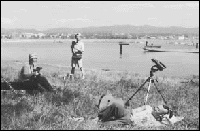|
|
|
監督・脚本・編集・音楽:原將人、金子ともかず、小沼亮子
Director, Script, Editing, Music : Hara Masato, Kaneko Tomokazu, |
1950年生まれ。16mmの作品『おかしさに彩られた悲しみのバラード』を製作、高校生で東京フィルムアートフェスティバルのグランプリ、およびATG賞を受賞する。1970年、大島渚監督の『東京■争戦後秘話』の脚本を担当。1973年には、3年をかけた『初国知所之天皇』(はつくにしらすめらみこと)を製作し、若い世代から圧倒的な支持を得た。1970年代後半からビデオ、教育映画、PR映画、また1980年代にはドキュメンタリーを中心としたテレビ番組を演出。レーザーディスクやアニメーション映像に取り組み、上映の場でライブ演奏を行うなど多才。 Born in 1950, as a high school student he produced the 16mm film A Sad Yet Funny Ballad which captured the Tokyo Film Art Festival's Grand Prix, as well as the ATG Prize. He scripted Oshima Nagisa's film The Man Who Left His Will on Film in 1970, and in 1973, after three years of work he completed The First Emperor which received acclaim from its young audience. In the late 1970s he began writing and directing videos, educational works and PR films, and beginning in the 1980s, added a focus on documentaries for television. Hara's works sometimes use mixed media, especially animation and laserdisc images; and he often combines his screenings with live performances.
1979年生まれ。現在は滋賀県大津市在住。小学校4年生の頃より不登校になるものの、親の理解のもとに育つ。いくつかのフリースクールでの様々な人々との出会いを経て、現在、模索中。 Born in 1979, currently living in Otsu, in Shiga prefecture. In his fourth year of primary school, he stopped going to school and began home schooling. Having made the acquaintance of various people during his free schooling, he is now in the middle of finding his own way.
1973年生まれ。京都芸術短期大学染織コース研究生終了。1995年より原のライブ映画の楽士を務める。 1997年2月京都のギャラリーマロニエで織作品の個展を開く。その後、映像による織物を目指し、本格的に映画を志す。京都在住。 Born in 1973, she completed a course of training at the Kyoto Junior Arts College in dyeing and weaving techniques. From 1995 she began working on Hara's live performances, and in 1997 had a one-person show of her works at Kyoto's Gallery Maronie. Following this, her attention has been focused on image-based works, with film being her mainstay. She lives in Kyoto. |
 |
|
|
監督のことば 『東京物語』『小早川家の秋』など映画史の一世紀目にホームドラマの傑作の数々を残した小津安二郎。その家族像に、血はつながっておらず、互いにカメラで撮り撮られる、映画だけでつながっている家族である“ロードムービー家”を対置してみた。 私と『百代の過客』のライブ上映ツアーのとき知り合った2人、金子ともかず(17)、小沼亮子(23)を息子と娘に見立てて1996年夏、5台のカメラとともに“ロードムービー家”は旅に出た。その旅を中心に3人で分担して編集し、それぞれナレーションをつけ、複数の私による私映画を試みた。3人ともその後も撮り続けているので各自の私映画は増殖していき…。さて’97年夏、“ロードムービー家”の旅は如何に─ いくつかの章に分かれたこの映画は3人の作り手による私映画集であるとともに、複数の一人称によるかけあいの章もある。これは私が前作でやり残していたことだった。実の息子と2人だけで撮った『百代の過客』で、撮影時のかけあいはあっても、私一人で編集したため編集時のかけあいがなかったことが心残りだったからである。したがって、この映画は原將人・金子ともかず・小沼亮子の共同監督作品となる。そしてライブ映画である。 16mm、8mm、ビデオによって撮られたこの映画は、素材毎に異なったプロジェクターで単面、二面、時には三面マルチで映写される。音楽、ナレーションもライブである。3人がそれぞれ監督した映像が章ごとに、あるいは同じ章のなかで交互に、まるでソロ演奏のパートのように入り乱れ、即興性に満ちた空間が増殖してゆくローテク・マルチメディアの試みだ。 この映画は96年に特別ライブ上映されたものを大幅にリニューアルした、97年バージョンである。 |
Director's Statement In the first century of cinema, Ozu Yasujiro has left us many masterpieces of domestic dramas including Tokyo Story ( " Tokyo Monogatari " ) and The End of Summer ( " Kohayagawa ke no aki " ). I contrasted his portrayals of families with the " Road Movie Family, " tied not by blood kinship, but by cinema, with each member of it pointing his or her camera at each other. With two people I met on the live screening tour of my previous film The Eternal Traveler ( " Hyakudai no kakaku " ), Kaneko Tomokazu (17) and Onuma Ryoko (23), posing as my son and my daughter, the " Road Movie Family " went on voyage in the summer of 1996, taking five cameras with them. This journey became the core of our film, with each of us editing his or her own part, adding his or her own voice-over, trying to achieve an " I-movie " with several " I " s. The three of us have been continuing to film after that, so each " I-movie " is still in course of multiplying. So what will become of the " Road Movie Family " in the summer of 1997? This film, divided into several chapters, is a compilation of " I-movies " of the three filmmakers, but it also includes chapters with the three first-person voices in dialogue. This is what I have left undone in my previous film: The Eternal Traveler, which I shot with my own son, had dialogues in the shooting process, but not in the editing which I did just by myself. This I have regretted. So this becomes a co-directed film by Hara Masato, Kaneko Tomokazu and Onuma Ryoko. It is also a film to be performed live. The film is shot on 16mm, 8mm, and on video, and will be projected on a single, double, and sometime triple multi-screen using three projectors for the three different formats. The music and the voice-overs are to be performed live. Sometimes the three directors perform individually alongside the part they directed, and sometimes they perform in the same chapter, taking turns, like three soloists, and mixing their voices together-- an experiment in low-tech multimedia in which spaces filled with an improvisational atmosphere multiply themselves. The film to be presented in Yamagata is a largely-revised edition
of a version performed in 1996 as a special live screening. |